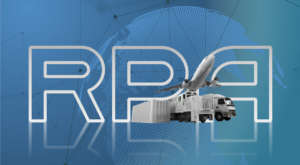Process automation is not new. Humans have historically automated processes as fast as they can by developing machines to do routine and monotonous work. Recently, however, the machines receiving attention in the process automation space are computers. Robotic Process Automation (RPA) involves software rather than hardware. Todd Smekens (@ToddSmekens) explains, “In essence, using robotic process automation in business allows specially-tailored software to mimic the activity of a human being to carry out various repetitive and routine tasks. Now, this doesn’t sound particularly revolutionary, as we have been automating functions for decades and have moved on to more sophisticated uses of AI. But one key differentiator of RPA vs. other AI is that this technology is run by a business owner or virtually any other employee — not just your everyday programmer. And these solutions are beginning to be rolled out at an enterprise level with tremendous success.”[1]
The Growth of Robotic Process Automation
“Digital has brought in so many technological advances to this age,” writes Sandeep Raut (@rautsan), Senior Director for Digital Transformation at Syntel, “and one of them is Robotic Process Automation.”[2] The Digital Age emerged as humans and machines began generating oceans of data which became available to be collected and analyzed. RPA is one of the tools developed to deal with all that data. Raut explains, “Today’s organizations often need to execute millions of repetitive and time-intensive business processes each day. Using RPA they can automate administrative functions such as customer address changes, registrations and other high-volume tasks and transactions. This helps avoid human errors and also allows employees to spend more time & focus on customer-related functions for better customer experience. RPA is well suited for processes that are clearly defined, repeatable and rules-based. Any company that uses workforce on a large scale for general knowledge process work, where people are performing high-volume, high-transactional process functions, will boost their capabilities and save money and time with RPA software. Process automation can expedite back-office tasks in finance, procurement, supply chain management, accounting, customer service and human resources, including data entry, purchase order issuing, a creation of online access credentials.”
Because RPA has so many potential uses, the market for RPA software is predicted to grow dramatically. Alison DeNisco Rayome reports, “IT leaders predict that 59% of business processes could be automated by 2022, according to a new study from Redwood Software and Sapio Research.”[3] Predictions about how large the RPA market is going grow varies. Market Research Future predicts the Robotic Process Automation market will grow to approximately $2.7 billion by 2023 with a compound annual growth rate (CAGR) of 29% between 2017 and 2023.[4] According to Arcluster the RPA market will nearly double the Market Research Future prediction and will reach $5.01 billion in 2022.[5] And P&S Market Research pegs the RPA market even higher at $6.247 billion by 2023, growing at a CAGR of 33.8% during 2017 – 2023.[6]
From Robotic to Cognitive Process Automation™
In talks with clients, I’ve found they want to go beyond RPA to what I call Cognitive Process Automation™ (CPA). Cognitive Process Automation goes beyond the accomplishment of routine tasks. CPA has the potential to not just automate, but to improve processes by dynamically processing and executing subtle decisions as if they were made by the best human expert. Leslie Willcocks, a professor of technology, work, and globalization at the London School of Economics, explains, “RPA deals with simpler types of task. It takes away mainly physical tasks that don’t need knowledge, understanding, or insight — the tasks that can be done by codifying rules and instructing the computer or the software to act. With cognitive automation, you impinge upon the knowledge base that a human being has and on other human attributes beyond the physical ability to do something. Cognitive automation can deal with natural language, reasoning, and judgment, with establishing context, possibly with establishing the meaning of things and providing insights. So there is a big difference between the two.”[7]
Raut asserts, “By adding the cognitive computing power of Natural language processing, speech recognition, and machine learning, businesses can achieve high-end tasks which require human interventions.” According to Stephanie Overby (@stephanieoverby), “Cognitive capabilities could supercharge RPA efforts automating tasks that once required the judgment and perception of humans.”[8] She explains:
“While the basic benefits of RPA are relatively straightforward, these emerging business process automation tools could also serve as an entry point for incorporating cognitive computing capabilities into the enterprise, says David Schatsky managing director with Deloitte. By injecting RPA with cognitive computing power, companies can supercharge their automation efforts, says Schatsky, who analyzes the implications of emerging technology and other business trends. By combining RPA with cognitive technologies such as machine learning, speech recognition, and natural language processing, companies can automate higher-order tasks that in the past required the perceptual and judgment capabilities of humans.”
Not all process automation tasks require cognitive capabilities. Anastassia Fedyk, a Ph.D. Candidate in business economics at Harvard Business School, explains, “Start by distinguishing between automation problems and learning problems. Machine learning can help automate your processes, but not all automation problems require learning. Automation without learning is appropriate when the problem is relatively straightforward. These are the kinds of tasks where you have a clear, predefined sequence of steps that is currently being executed by a human, but that could conceivably be transitioned to a machine. This sort of automation has been happening in businesses for decades. … So what are good business problems for machine learning methods? Essentially, any problems that: (1) require prediction rather than causal inference; and (2) are sufficiently self-contained, or relatively insulated from outside influences.”[9]
Summary
Smekens agrees many processes don’t require cognitive capabilities. “While RPA is a less advanced technology compared to AI that powers smart robots,” he writes, “it’s just as powerful. … Furthermore, because RPA doesn’t require coding or technical maintenance, these solutions are more likely to be utilized by everyday professionals who are looking to automate tedious business tasks that don’t often need a lot of in-depth knowledge or understanding.” Raut concludes, “As RPA brings more technologically-advanced solutions to businesses around the world, they bring a multitude of benefits: Increased Speed (routine tasks are carried out swiftly by RPA without any intervention, thereby faster time to resolution); reduced labor costs due to software robots than humans; enhanced employee experience (since repetitive tasks as taken care by RPA, employees can spend quality time for strategic work and enjoy their work life); higher quality (better consistency & accuracy due to minimized variations and better customer service); enhanced insights (by automating the data collected and applying Big Data analytics for improved efficiency); and scalability (robotic workforce can be scaled to any level required).” Whether a company requires Robotic Process Automation, Cognitive Process Automation, or both, businesses are stepping into a new business environment.
Footnotes
[1] Todd Smekens, “Robotic Process Automation: Are You Ready for This New Digital Employee?,” Muncie Voice, 14 October 2017.
[2] Sandeep Raut, “How Robotic Process Automation helping Digital Age,” Simplified Analytics, 8 October 2017.
[3] Alison DeNisco Rayome, “Report: Nearly 60% of all business processes could be automated by 2022,” TechRepublic, 4 October 2017.
[4] PRNewswire, “Robotic Process Automation Market Worth 2,700 Million USD by 2023,” BWW Geeks World, 19 June 2017.
[5] ReleaseWire, “Worldwide Robotic Process Automation Market Set to Exceed $5 Billion in 2022,” Digital Journal, 19 September 2017.
[6] P&S Market Research, “Robotic Process Automation Market to Reach $6,247.1 Million by 2023: P&S Market Research,” EconoTimes, 23 June 2017.
[7] Xavier Lhuer, “The next acronym you need to know about: RPA (robotic process automation),” McKinsey & Company, December 2016.
[8] Stephanie Overby, “Robotic process automation is killer app for cognitive computing,” CIO, 4 November 2016.
[9] Anastassia Fedyk, “How to Tell If Machine Learning Can Solve Your Business Problem,” Harvard Business Review, 25 November 2016.





